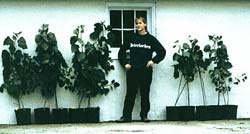Latest News

Dot, dot, dot . . . How quantum dots line up
A method that can be used to predict the growth of earthquake faults also aids prediction of the tiniest of phenomena–how arrays of “artificial atoms,” or quantum dots, assemble and stack themselves on semiconductor materials, National Institute of Standards and Technology (NIST) researchers report in the July 15 issue of Physical Review B.
The insight could aid development of more reliable methods for fabricating lasers, sensors and other devices that exploit quantum dots’ special el

Tiny Bubbles: New tool in chemical sensing?
As the old Hawaiian love song says, tiny bubbles really do make some people feel fine. Chemists, that is. But there is no wine involved this time, just water.
National Institute of Standards and Technology (NIST) chemists reported in the June 24 online edition of Langmuir that a process called microboiling shows promise for quick, simple and inexpensive chemical sensing. The process involves the formation of tiny vapor bubbles on a 200-nanometer-thick film of precious metal immersed in wat

Genome researcher analyze chromosome 7
New study discovers unusual structural features implicated in disease
A detailed analysis of the reference sequence of chromosome 7 has uncovered structural features that appear to promote genetic changes that can cause disease, researchers from the International Human Genome Sequencing Consortium said today.
In a study published in the July 10 issue of the journal Nature, a multi-institution team, led by the Washington University School of Medicine in St. Louis, reported it

Sequence of human chromosome 7 is fine-tuned and finished
Researchers at Washington University School of Medicine in St. Louis, in collaboration with investigators at five other centers, have finished sequencing human chromosome 7. The findings are published in the July 10 issue of the journal Nature.
Chromosome 7 is the largest human chromosome to be sequenced so far. The analysis revealed that the chromosome has about 1,150 genes and 940 so-called pseudogenes, stretches of DNA that closely resemble genes but contain some genetic change that prev

Plant genes imported from unrelated species more often than previously thought, IU biologists find
Scientists have long thought gene exchange between individuals of unrelated species to be an extremely rare event among eukaryotes — the massive group of organisms that counts among its members humans, oak trees, kelp and mushrooms — throughout the group’s 2 billion year history.
But a new Indiana University Bloomington study in this week’s Nature suggests that such genetic events, called horizontal gene transfers, have happened more often than previously thought during the evol

City-grown air pollution is tougher on country trees
A tree grows in Brooklyn — despite big-city air pollutants. Meanwhile, identical trees planted downwind of city pollution grow only half as well — a surprising finding that ecologists at Cornell University and the Institute of Ecosystem Studies (IES) reported in the current issue of Nature (July 10, 2003). They attribute the effect to an atmospheric-chemistry “footprint” that favors city trees.
“I know this sounds counterintuitive but it’s true. City-grown pollution — and ozone in parti











